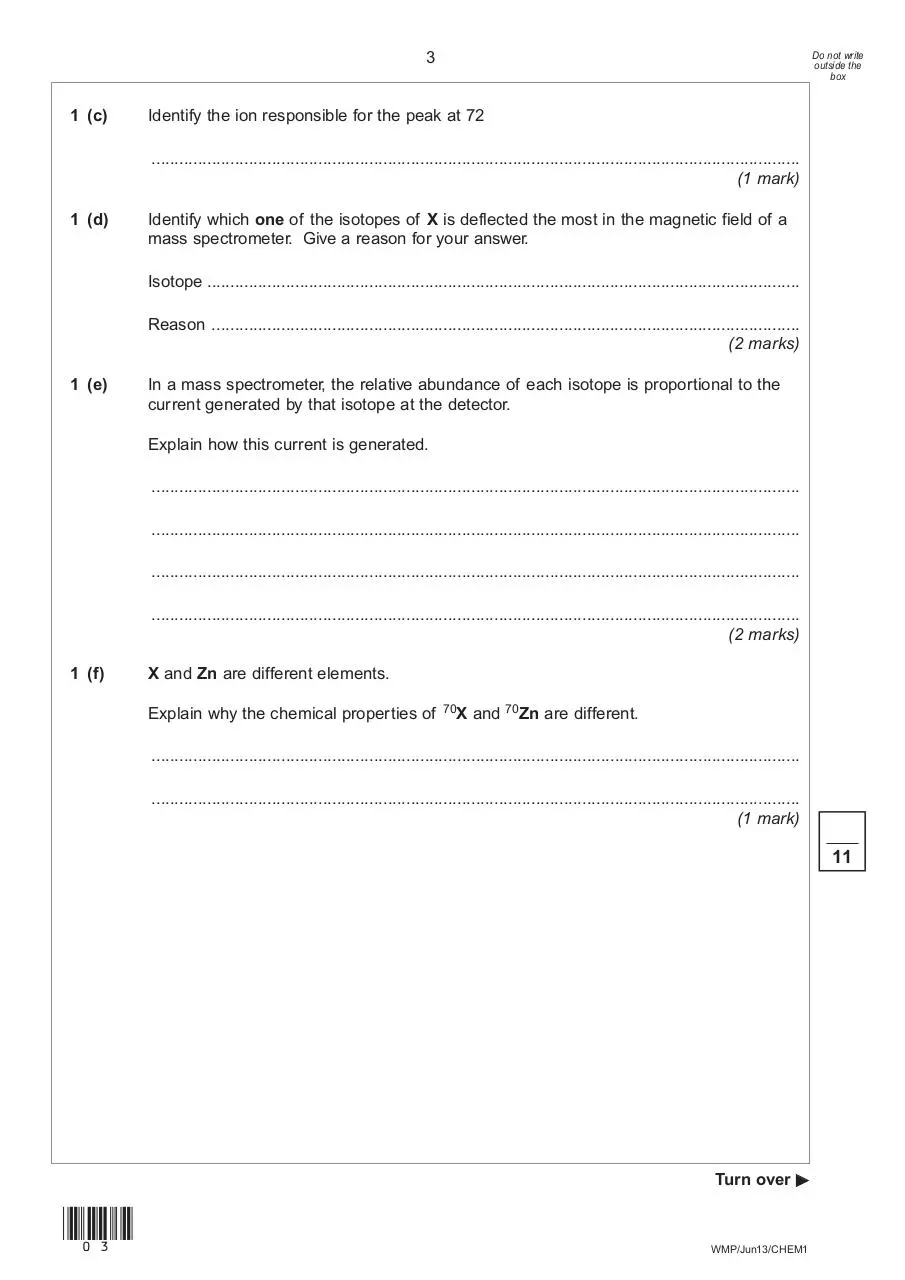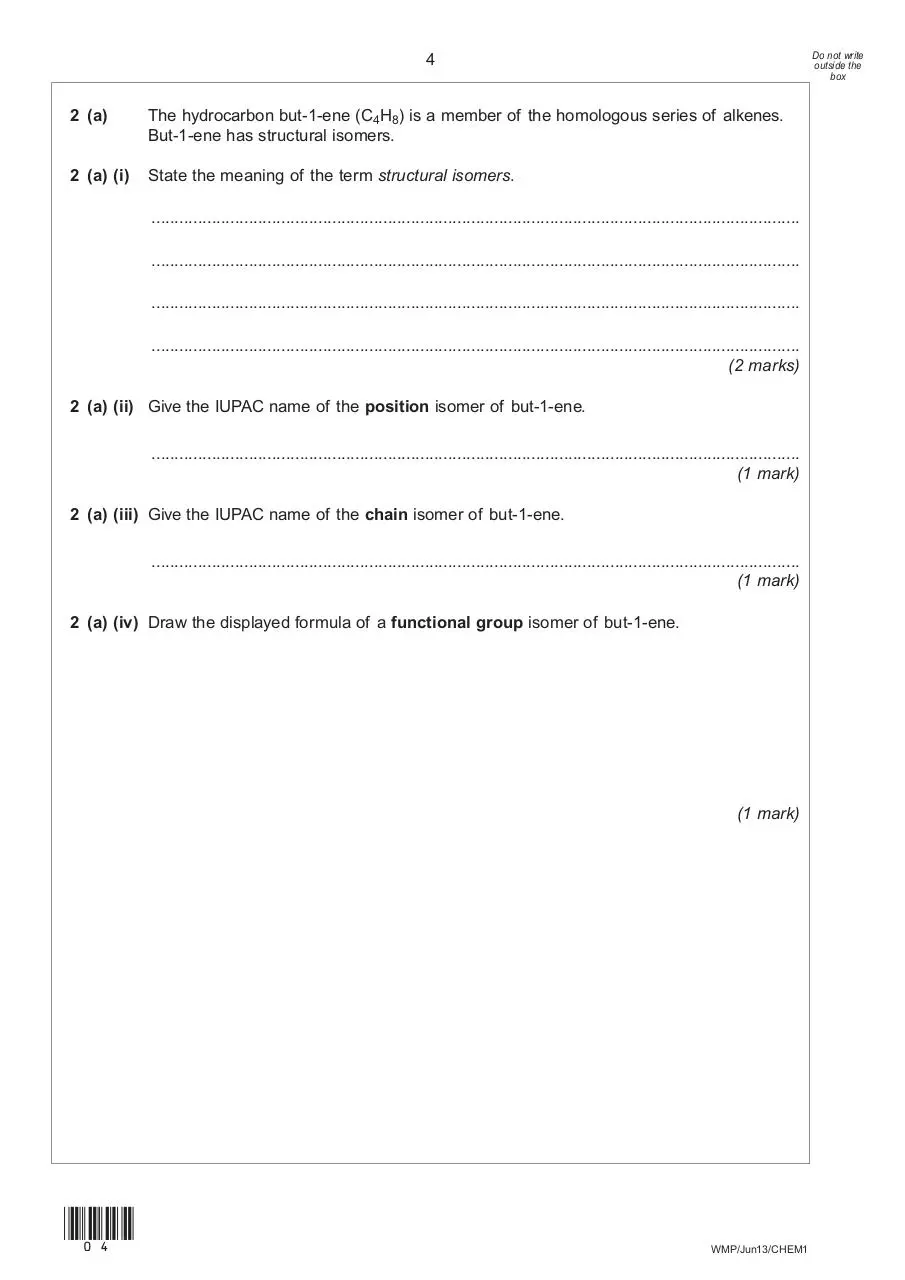AS Jun 13 (PDF)
File information
This PDF 1.6 document has been generated by , and has been sent on pdf-archive.com on 28/02/2017 at 16:02, from IP address 81.108.x.x.
The current document download page has been viewed 588 times.
File size: 1.32 MB (40 pages).
Privacy: public file





File preview
Centre Number
For Examiner’s Use
Candidate Number
Surname
Other Names
Examiner’s Initials
Candidate Signature
Question
General Certificate of Education
Advanced Subsidiary Examination
June 2013
Mark
1
2
3
Chemistry
Unit 1
CHEM1
5
Foundation Chemistry
Thursday 23 May 2013
4
6
9.00 am to 10.15 am
7
8
For this paper you must have:
l the Periodic Table/Data Sheet, provided as an insert
(enclosed)
l a calculator.
TOTAL
Time allowed
l 1 hour 15 minutes
Instructions
l Use black ink or black ball-point pen.
l Fill in the boxes at the top of this page.
l Answer all questions.
l You must answer the questions in the spaces provided. Do not write
outside the box around each page or on blank pages.
l All working must be shown.
l Do all rough work in this book. Cross through any work you do not
want to be marked.
Information
l The marks for questions are shown in brackets.
l The maximum mark for this paper is 70.
l You are expected to use a calculator where appropriate.
l The Periodic Table/Data Sheet is provided as an insert.
l Your answers to the questions in Section B should be written in
continuous prose, where appropriate.
l You will be marked on your ability to:
– use good English
– organise information clearly
– use scientific terminology accurately.
Advice
l You are advised to spend about 50 minutes on Section A and about
25 minutes on Section B.
(JUN13CHEM101)
WMP/Jun13/CHEM1
CHEM1
Do not write
outside the
box
2
Section A
Answer all questions in the spaces provided.
1
The mass spectrum of the isotopes of element X is shown in the diagram.
5
4
Relative
abundance
3
2
1
0
69
70
71
72
73
74
75
m/z
1 (a)
Define the term relative atomic mass.
............................................................................................................................................
............................................................................................................................................
............................................................................................................................................
............................................................................................................................................
(2 marks)
1 (b)
Use data from the diagram to calculate the relative atomic mass of X.
Give your answer to one decimal place.
............................................................................................................................................
............................................................................................................................................
............................................................................................................................................
............................................................................................................................................
............................................................................................................................................
............................................................................................................................................
(3 marks)
(02)
WMP/Jun13/CHEM1
Do not write
outside the
box
3
1 (c)
Identify the ion responsible for the peak at 72
............................................................................................................................................
(1 mark)
1 (d)
Identify which one of the isotopes of X is deflected the most in the magnetic field of a
mass spectrometer. Give a reason for your answer.
Isotope ................................................................................................................................
Reason ...............................................................................................................................
(2 marks)
1 (e)
In a mass spectrometer, the relative abundance of each isotope is proportional to the
current generated by that isotope at the detector.
Explain how this current is generated.
............................................................................................................................................
............................................................................................................................................
............................................................................................................................................
............................................................................................................................................
(2 marks)
1 (f)
X and Zn are different elements.
Explain why the chemical properties of
70X
and
70Zn
are different.
............................................................................................................................................
............................................................................................................................................
(1 mark)
11
Turn over
(03)
䊳
WMP/Jun13/CHEM1
Do not write
outside the
box
4
2 (a)
The hydrocarbon but-1-ene (C4H8) is a member of the homologous series of alkenes.
But-1-ene has structural isomers.
2 (a) (i)
State the meaning of the term structural isomers.
............................................................................................................................................
............................................................................................................................................
............................................................................................................................................
............................................................................................................................................
(2 marks)
2 (a) (ii) Give the IUPAC name of the position isomer of but-1-ene.
............................................................................................................................................
(1 mark)
2 (a) (iii) Give the IUPAC name of the chain isomer of but-1-ene.
............................................................................................................................................
(1 mark)
2 (a) (iv) Draw the displayed formula of a functional group isomer of but-1-ene.
(1 mark)
(04)
WMP/Jun13/CHEM1
Do not write
outside the
box
5
2 (b)
But-1-ene burns in a limited supply of air to produce a solid and water only.
2 (b) (i)
Write an equation for this reaction.
............................................................................................................................................
(1 mark)
2 (b) (ii) State one hazard associated with the solid product in part (b) (i).
............................................................................................................................................
(1 mark)
2 (c)
One mole of compound Y is cracked to produce two moles of ethene, one mole of
but-1-ene and one mole of octane (C8H18) only.
2 (c) (i)
Deduce the molecular formula of Y.
............................................................................................................................................
(1 mark)
2 (c) (ii) Other than cracking, give one common use of Y.
............................................................................................................................................
(1 mark)
2 (d)
In cars fitted with catalytic converters, unburned octane reacts with nitrogen monoxide
to form carbon dioxide, water and nitrogen only.
2 (d) (i)
Write an equation for this reaction.
............................................................................................................................................
(1 mark)
2 (d) (ii) Identify a catalyst used in a catalytic converter.
............................................................................................................................................
(1 mark)
11
Turn over
(05)
䊳
WMP/Jun13/CHEM1
Do not write
outside the
box
6
3
In 2009 a new material called graphane was discovered. The diagram shows part of a
model of the structure of graphane. Each carbon atom is bonded to three other
carbon atoms and to one hydrogen atom.
3 (a)
Deduce the type of crystal structure shown by graphane.
............................................................................................................................................
(1 mark)
3 (b)
State how two carbon atoms form a carbon–carbon bond in graphane.
............................................................................................................................................
............................................................................................................................................
(1 mark)
3 (c)
Suggest why graphane does not conduct electricity.
............................................................................................................................................
............................................................................................................................................
(1 mark)
3 (d)
Deduce the empirical formula of graphane.
............................................................................................................................................
(1 mark)
4
(06)
WMP/Jun13/CHEM1
Do not write
outside the
box
7
4
Fritz Haber, a German chemist, first manufactured ammonia in 1909.
Ammonia is very soluble in water.
4 (a)
State the strongest type of intermolecular force between one molecule of ammonia and
one molecule of water.
............................................................................................................................................
(1 mark)
4 (b)
Draw a diagram to show how one molecule of ammonia is attracted to one molecule of
water. Include all partial charges and all lone pairs of electrons in your diagram.
(3 marks)
4 (c)
Phosphine (PH3) has a structure similar to ammonia.
In terms of intermolecular forces, suggest the main reason why phosphine is almost
insoluble in water.
............................................................................................................................................
............................................................................................................................................
(1 mark)
5
Turn over
(07)
䊳
WMP/Jun13/CHEM1
Do not write
outside the
box
8
5
Aluminium and thallium are elements in Group 3 of the Periodic Table.
Both elements form compounds and ions containing chlorine and bromine.
5 (a)
Write an equation for the formation of aluminium chloride from its elements.
............................................................................................................................................
(1 mark)
5 (b)
An aluminium chloride molecule reacts with a chloride ion to form the AlCl4− ion.
Name the type of bond formed in this reaction. Explain how this type of bond is
formed in the AlCl4− ion.
Type of bond ......................................................................................................................
Explanation .........................................................................................................................
............................................................................................................................................
............................................................................................................................................
(2 marks)
5 (c)
Aluminium chloride has a relative molecular mass of 267 in the gas phase.
Deduce the formula of the aluminium compound that has a relative molecular mass
of 267
............................................................................................................................................
(1 mark)
5 (d)
Deduce the name or formula of a compound that has the same number of atoms, the
same number of electrons and the same shape as the AlCl4− ion.
............................................................................................................................................
(1 mark)
5 (e)
Draw and name the shape of the TlBr52− ion.
Shape of the TlBr52− ion.
Name of shape ..................................................................................................................
(2 marks)
(08)
WMP/Jun13/CHEM1
Do not write
outside the
box
9
5 (f) (i)
Draw the shape of the TlCl2+ ion.
(1 mark)
5 (f) (ii) Explain why the TlCl2+ ion has the shape that you have drawn in part (f) (i).
............................................................................................................................................
............................................................................................................................................
............................................................................................................................................
(1 mark)
5 (g)
Which one of the first, second or third ionisations of thallium produces an ion with the
electron configuration [Xe] 5d106s1?
Tick (✓) one box.
First
Second
Third
(1 mark)
10
Turn over
(09)
䊳
WMP/Jun13/CHEM1
Download AS Jun 13
AS Jun 13.pdf (PDF, 1.32 MB)
Download PDF
Share this file on social networks
Link to this page
Permanent link
Use the permanent link to the download page to share your document on Facebook, Twitter, LinkedIn, or directly with a contact by e-Mail, Messenger, Whatsapp, Line..
Short link
Use the short link to share your document on Twitter or by text message (SMS)
HTML Code
Copy the following HTML code to share your document on a Website or Blog
QR Code to this page

This file has been shared publicly by a user of PDF Archive.
Document ID: 0000561759.